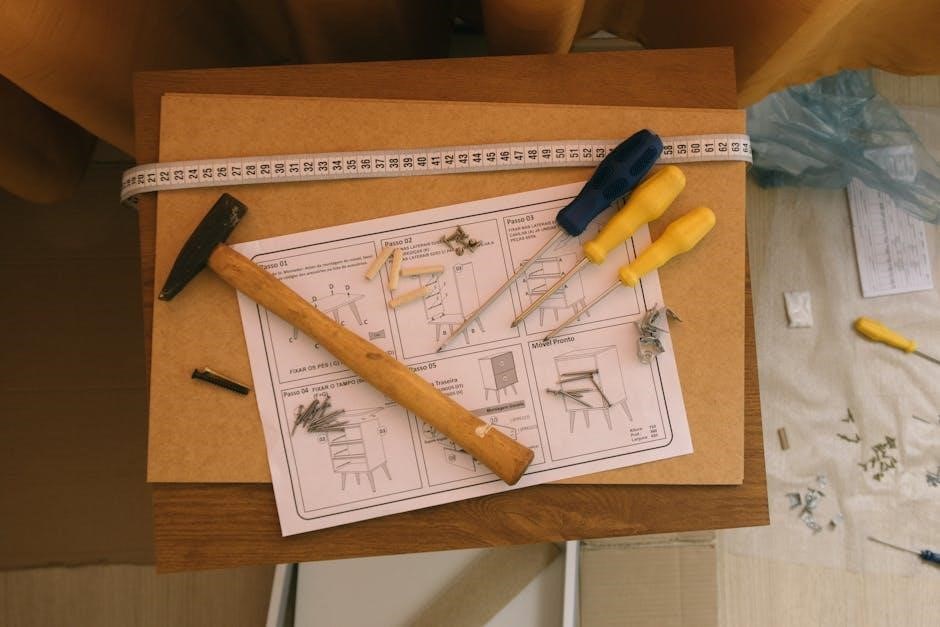Welcome to the Hossfeld Bender Instruction Manual, your comprehensive guide to understanding and operating the Hossfeld Bender. This manual is designed to provide step-by-step instructions for installation, operation, and maintenance, ensuring optimal performance and safety. Compatible with major brands, it offers detailed insights into features, troubleshooting, and best practices for professionals and beginners alike.
1.1 Overview of the Hossfeld Bender
The Hossfeld Bender is a versatile and durable tool designed for bending various materials with precision and ease. Known for its compatibility with major brands, it is widely used in industrial, automotive, and DIY settings. This bender is celebrated for its robust construction and user-friendly design, making it suitable for both professionals and beginners. Whether for manual or hydraulic operations, the Hossfeld Bender delivers consistent results, ensuring accurate bends every time. Its universal appeal lies in its adaptability to different projects, making it an essential addition to any workshop or fabrication setup.
1.2 Importance of the Instruction Manual
The Hossfeld Bender Instruction Manual is a crucial resource for ensuring safe, efficient, and effective use of the equipment. It provides detailed guidance on installation, operation, and maintenance, helping users maximize productivity while minimizing risks. The manual includes troubleshooting tips, diagrams, and specifications, making it an indispensable tool for both novice and experienced operators. By following the manual’s instructions, users can avoid common mistakes, extend the lifespan of the bender, and achieve professional-grade results. Its comprehensive coverage ensures that users are well-equipped to handle various bending tasks with confidence and precision.
1.3 Compatible Brands and Models
The Hossfeld Bender Instruction Manual is compatible with a wide range of brands and models, ensuring versatility for various applications. It supports major manufacturers, including Clausing and Colchester, and is adaptable to different tube bending requirements. Whether you’re using the Hossfeld Universal No. 2 Bender or other compatible models, this manual provides tailored guidance. Its broad compatibility makes it a valuable resource for workshops and professionals working with diverse equipment. The manual’s universal approach ensures seamless integration with existing machinery, enhancing productivity and flexibility in different operational settings while maintaining consistent performance and reliability across all supported brands and models.

Installation and Setup
Installation is quick and easy using four bolts, following simple, illustrated instructions. Ensure all components are securely fastened for safe and proper setup.
2.1 Hardware Requirements for Installation
To install the Hossfeld Bender, ensure you have the necessary hardware, including four bolts for mounting. The device is compatible with major brands and requires basic tools like wrenches and screwdrivers. Additional components may include hydraulic hoses and fittings for power mode. Ensure all parts are included in the package or purchased separately if needed. Refer to the provided diagrams for clarity. Having the correct hardware on hand will ensure a smooth and efficient setup process. Proper installation is crucial for safety and performance, so double-check all connections before use.

2.2 Step-by-Step Installation Guide
Begin by unpacking the Hossfeld Bender and verifying all components are included. Choose a stable, flat surface for installation and ensure it is clear of obstructions. Mount the bender using the provided bolts, following the illustrated instructions for proper alignment. Connect the hydraulic system if using power mode, ensuring all hoses and fittings are securely attached. Tighten all connections according to the torque specifications provided. Refer to the diagrams for visual guidance. Once installed, perform a final check to ensure stability and proper function. This step-by-step process ensures a safe and efficient setup for optimal performance.
2.3 Switching Between Power and Manual Modes
To switch between power and manual modes on your Hossfeld Bender, begin by disconnecting the power source for safety. Locate the mode selection switch, typically found on the control panel, and move it to the desired position. For manual mode, ensure the hydraulic system is disengaged and the bending lever is accessible. In power mode, reconnect the power supply and follow the startup sequence outlined in the manual. Always refer to the diagrams provided for visual confirmation. This feature allows for versatility in operation, accommodating both precision and efficiency in different work scenarios.

Key Features of the Hossfeld Bender
The Hossfeld Bender offers exceptional bending capacity, adjustable settings for precision, and compatibility with major brands, ensuring versatility and efficiency in various applications.
3.1 Bending Capacity and Specifications
The Hossfeld Bender excels with a robust bending capacity, capable of handling various tube sizes and materials. Its specifications ensure precise control over bending angles and pressures, making it suitable for both light-duty and heavy-duty applications. The machine’s durability and versatility allow it to adapt to different project requirements, providing consistent results. Whether for fabrication, automotive, or industrial use, the Hossfeld Bender delivers reliable performance, meeting the demands of professionals and hobbyists alike. Its advanced design and sturdy construction make it a trusted tool in any workshop setting.
3.2 Adjustable Settings for Precision Bending
The Hossfeld Bender features adjustable settings that enable precise control over bending operations. With customizable stops, pressure controls, and angle adjustments, users can achieve accurate and repeatable results. The machine allows for fine-tuning of bending parameters, ensuring compatibility with various materials and tube sizes. Its intuitive design enables quick adjustments, making it ideal for complex fabrication tasks. Whether you’re bending aluminum, steel, or other materials, the adjustable settings provide the flexibility needed for professional-grade outcomes. This feature-rich system ensures that every bend meets exact specifications, enhancing efficiency and productivity in any workshop environment.

Operating the Hossfeld Bender
Operating the Hossfeld Bender involves a seamless process with user-friendly controls and clear guidelines. The machine offers both manual and hydraulic modes, ensuring versatility for different tasks and materials.
4.1 Pre-Operation Checklist
Before operating the Hossfeld Bender, ensure all safety and preparation steps are followed. Inspect the machine for any damage or wear. Lubricate moving parts as recommended. Tighten all bolts and connections. Check hydraulic fluid levels and ensure the system is free from leaks. Wear appropriate protective gear, including gloves and safety glasses. Review the manual for specific material requirements. Test the bending operation with a scrap piece to ensure accuracy. Clear the workspace of obstacles. Finally, consult the manual for any model-specific pre-operation checks to guarantee safe and efficient use.
4.2 Manual Bending Mode
Engage manual bending mode for precise control over small or intricate bends. Ensure the machine is set to manual operation. Position the tube or pipe securely in the bending die, aligning it with the marked guide. Slowly apply even pressure to the bending handle, monitoring the bend’s progression. Use the provided gauge or measuring tool to achieve the desired angle. Avoid sudden movements to maintain accuracy. If resistance is felt, stop and adjust the setup. Always ensure the workpiece is firmly seated to prevent slippage. This mode is ideal for small-scale projects or when exact manual control is required.
4.3 Hydraulic Bending Mode
Hydraulic bending mode offers enhanced speed and precision for demanding tasks. Ensure the machine is powered on and set to hydraulic operation. Position the tube or pipe in the bending die, aligning it with the guide marks. Use the control lever to activate the hydraulic system, applying steady pressure until the desired bend is achieved. Monitor the bending process closely to avoid over-bending. Always follow the recommended pressure settings provided in the manual; This mode is ideal for heavy-duty applications and large-scale projects, delivering consistent and accurate results. Regular maintenance of hydraulic components is crucial for optimal performance.
4.4 Quick Start Guide for Beginners
Welcome to the Hossfeld Bender! This quick start guide helps you get started effortlessly. Begin by unpacking and inspecting the machine for any damage. Ensure all safety precautions are in place, including wearing protective gear. Familiarize yourself with the controls and modes. For initial use, switch to manual mode for practice. Align the tube or pipe with the bending die, secure it firmly, and apply steady pressure to achieve the desired bend. Refer to the manual for specific settings and guidelines. Practice on scrap material to build confidence. The Hossfeld Bender is designed for precision and durability, making it easy to master with time.

Maintenance and Care
Regular cleaning and lubrication ensure optimal performance. Inspect wearable parts and replace them as needed. Proper storage and transportation practices help maintain the machine’s longevity and functionality effectively.
5.1 Cleaning and Lubrication
Regular cleaning is essential to maintain the Hossfeld Bender’s performance. Use a mild detergent and a soft cloth to wipe down surfaces, removing dirt and grime. Lubricate moving parts, such as hinges and gears, to ensure smooth operation. Avoid over-lubrication, as it may attract dust and contaminants. Refer to the manual for recommended lubricants and cleaning schedules. Proper maintenance prevents wear and extends the lifespan of the machine. Always clean before storage to prevent rust and corrosion. Lubrication should be reapplied after cleaning to protect metal components. Follow these steps to keep your Hossfeld Bender in optimal condition and ensure precise bending results.
5.2 Replacing Wearable Parts
Regular inspection and timely replacement of wearable parts are crucial for maintaining the Hossfeld Bender’s performance. Always disconnect power before servicing. Use the manual to identify wearable components like pins, bushings, and seals. Replace these parts with genuine Hossfeld replacements to ensure compatibility and reliability. Follow the disassembly and reassembly instructions carefully to avoid damage. Proper alignment and tightening are essential to maintain precision. Keep a record of replacements to track maintenance history. Addressing wear promptly prevents costly repairs and downtime, ensuring smooth operation and consistent bending results. Always refer to the manual for specific replacement procedures and guidelines. Regular maintenance extends the machine’s lifespan and efficiency.

5.3 Storage and Transportation Tips
Proper storage and transportation of the Hossfeld Bender are essential to maintain its functionality and longevity. Store the machine in a dry, clean environment, away from direct sunlight and moisture. Use a protective cover to prevent dust accumulation. For transportation, secure the bender firmly to prevent movement. Use the original packaging or equivalent materials for safe transit. Disconnect power sources and ensure all hydraulic fluid is drained if transporting a hydraulic model. Always check for loose parts before moving; Follow these guidelines to protect your Hossfeld Bender during storage and transport, ensuring it remains in optimal condition for future use.

Troubleshooting Common Issues
This section addresses common problems users may encounter with the Hossfeld Bender, providing solutions and error code explanations to ensure smooth operation and quick resolution of issues.
6.1 Identifying Common Problems
Common issues with the Hossfeld Bender include malfunctioning hydraulic systems, inconsistent bending accuracy, and wear on movable parts. Users may also encounter difficulties switching between power and manual modes. Error codes often indicate specific problems, such as low hydraulic pressure or overheating. Additionally, improper lubrication or misaligned dies can lead to operational inefficiencies. This section helps identify these issues quickly, ensuring minimal downtime and maintaining productivity. By addressing root causes, users can resolve problems effectively and extend the lifespan of their Hossfeld Bender.
6.2 Error Codes and Solutions
The Hossfeld Bender displays error codes to indicate specific issues. For example, “E001” may signify low hydraulic pressure, while “E002” could point to overheating. Refer to the manual for a detailed list of codes and their meanings; Solutions often involve checking fluid levels, ensuring proper cooling, or recalibrating settings. If “E003” appears, inspect the bending die alignment and adjust as needed. Always power off the machine before attempting repairs. Consult the troubleshooting section for step-by-step fixes to restore functionality quickly and safely, minimizing downtime and ensuring precise bending operations.

Safety Precautions
Always wear protective gear, including gloves and safety glasses. Ensure proper training before operating. Keep loose clothing tied back and avoid jewelry. Maintain a clean workspace. Never bypass safety features.
7.1 Safe Handling Practices
Always prioritize safety when operating the Hossfeld Bender. Wear protective gear, including safety glasses and gloves, to prevent injury. Ensure loose clothing and jewelry are secured. Avoid wearing anything that could get caught in moving parts. Keep the workspace clean and clear of debris to minimize hazards. Never operate the machine while fatigued or distracted. Follow all instructions in the manual carefully, and avoid bypassing safety features. Regularly inspect the machine for damage or wear. Proper handling practices ensure a safe and efficient bending process. Stay alert and maintain focus during operation to avoid accidents.
7.2 Protective Gear and Workplace Safety
Always use appropriate protective gear when operating the Hossfeld Bender, including safety glasses, gloves, and a face mask. Ensure the workplace is well-ventilated and free from flammable materials. Keep emergency exits accessible and maintain proper lighting. Wear steel-toe boots and avoid loose clothing that could get caught in machinery. Ensure all employees are trained in workplace safety protocols. Regularly inspect equipment and surroundings to prevent hazards. Proper safety measures protect both the operator and the equipment, ensuring a safe and efficient working environment. Adhere to all safety guidelines to minimize risks and prevent accidents during operation.

Appendices
This section includes essential resources like technical specifications, detailed diagrams, and a glossary of terms to enhance your understanding and operation of the Hossfeld Bender.
8.1 Technical Specifications
The technical specifications section provides detailed information on the Hossfeld Bender’s capabilities, including bending capacity, compatible materials, and operational parameters. It outlines the machine’s dimensions, weight, and power requirements, ensuring proper installation and setup. This section also lists compatible brands and models, helping users verify compatibility before use. Additionally, it includes torque ratings, pressure settings, and recommended lubricants for optimal performance. These specifications are essential for understanding the machine’s limitations and ensuring safe, efficient operation. Refer to this section for precise data to guide your setup and usage of the Hossfeld Bender effectively.
8.2 Diagrams and Illustrations
This section contains detailed diagrams and illustrations to help users understand the Hossfeld Bender’s components and operations. Visual guides include exploded views of parts, assembly instructions, and step-by-step bending processes. These visuals aid in identifying components, troubleshooting, and performing maintenance tasks. They also provide clear instructions for switching between power and manual modes. The diagrams are complemented by labels and annotations, ensuring clarity for both novice and experienced users. Referencing these illustrations will enhance your ability to utilize the Hossfeld Bender effectively and safely, making complex tasks more approachable and understandable.
8;3 Glossary of Terms
This section provides a glossary of terms related to the Hossfeld Bender, ensuring clarity for users. Definitions include technical terms like “bending capacity,” “hydraulic mode,” and “wearable parts.” Each term is explained concisely to aid understanding. This glossary helps users familiarize themselves with the terminology used throughout the manual, making it easier to follow instructions and troubleshoot issues. By referencing this section, users can ensure proper usage and maintenance of the Hossfeld Bender, enhancing their overall experience with the equipment. Clear definitions are essential for safe and effective operation. This glossary serves as a quick reference guide.
Congratulations on completing the Hossfeld Bender Instruction Manual! This guide has provided you with the knowledge to master your device. Always operate safely and refer back to this manual for future assistance. Happy bending!
9.1 Final Tips for Optimal Use
To maximize the performance of your Hossfeld Bender, always follow the manufacturer’s guidelines and maintain regular lubrication. Ensure all bolts are tightened securely before operation. For precise bends, use the correct die set and refer to the bending chart provided. Store the machine in a dry, clean environment to prevent rust. Keep the manual handy for quick troubleshooting. Regularly inspect wearable parts and replace them as needed. Never exceed the machine’s bending capacity, and always wear protective gear. By adhering to these tips, you’ll extend the lifespan of your Hossfeld Bender and ensure consistent, professional results.
9.2 Resources for Further Assistance
For additional support, visit the official Hossfeld website or contact their customer service team. Authorized dealers offer genuine parts and expert advice. Online forums and communities provide valuable insights from experienced users. Refer to the comprehensive technical specifications in the appendices for detailed information. For troubleshooting, consult the error codes section or reach out to certified technicians. The Hossfeld Bender instruction manual is also available for download on their official website. Ensure to only use genuine replacement parts for optimal performance and safety.
